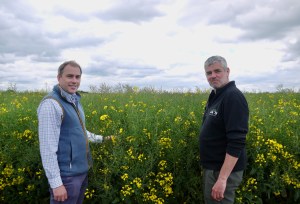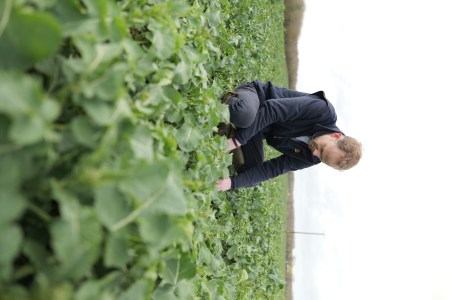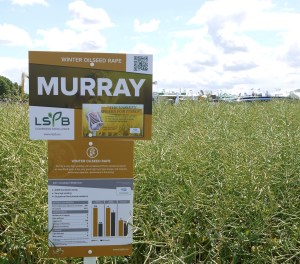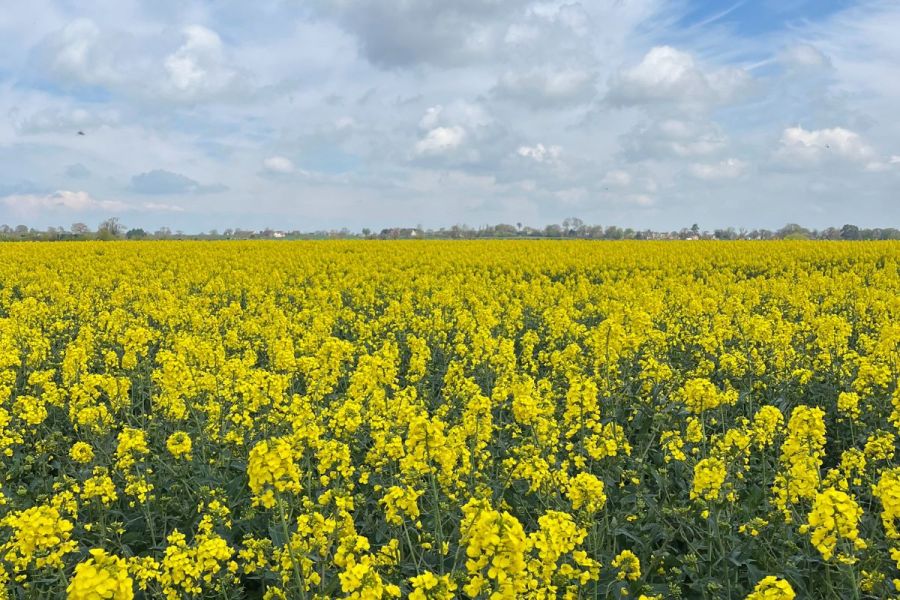Murray, the latest oilseed rape variety from LSPB, has shown promise in the East and West and could potentially draw the eye of those beyond these regions. CPM learns more about what this new variety has to offer.
“Murray offers growers an alternative source of phoma resistance so that they can spread their resources.”
By Melanie Jenkins
Growers in the East/West region of the UK may have noticed a new oilseed rape contender on the AHDB Recommended List. Murray is a high yielding variety in this region with notable disease resistance ratings.
Coming out of the European breeding programme of LSPB and its Germany shareholder NPZ, Murray is the result of the combined effort of the UK and German teams, says the firm’s Chris Guest. “The variety’s doing well in Germany, Denmark and Sweden too, so it’s exciting to have something with such broad appeal.

Chris Guest and Craig Padley feel that Murray has performed well and been consistent and stable across different regions.
“From an East/West perspective, Murray is very strong and so is its overall UK yield, but its northern performance is not where we’d like it to be. As a result, the variety didn’t get recommended for the North.”
Chris Guest feels that Murray has proved it can perform consistently though, with only a 4% swing in gross output between 2020 and 2022. “Oil content is obviously an important part of this and admittedly it’s a little lower than we’d really like, but generally it’s pretty acceptable at 44.5%. However, oil contents across the RL looked to be lower in general last year.”
According to Craig Padley of LSPB, Murray’s performance has been stable across different trial sites throughout its trial period, and the variety has demonstrated similar characteristics to previous LSPB varieties, Avatar and Wembley.
Chris Guest feels that light leaf spot is one area growers and breeders are paying ever closer attention to. “We’re seeing it become more and more prevalent across the UK and looking at the AHDB LLS forecast, the entire country is in red – so at high risk. Going back a decade, we might have seen Scotland and northern England classified as high-risk zones, but now it’s so widespread that having robust LLS resistance in varieties is really important across the whole country.
“There’s a direct correlation between LLS resistance and yield, so the stronger the resistance the more yield security growers are likely to have,” he adds. “This really shows up in Murray’s untreated yield and we also think that with its resistance, the variety can perform in Scotland where the benefits will really show.”

There’s a direct correlation between LLS resistance and yield, so the stronger the resistance the more yield security growers are likely to have, says Chris Piggott.
Murray has a 7 for LLS on the RL, says Craig. “It’s quite difficult to score better than this, though we did manage to with Vegas. However, we’d still encourage growers to apply fungicides when needed but the high resistance rating gives greater flexibility with timings and protects the genetic resistance.”
Further backing up Murray’s untreated yield is its phoma stem canker resistance, says Chris Guest. “We talked about phoma a lot a few years ago and since then we’ve been aiming to broaden the genetic resistance to the disease. We’ve now got four varieties with the RlmS resistance gene.
“The past couple of seasons have seen a slippage in the disease resistance of varieties with the Rlm7 gene and we’re seeing a much larger percentage of the population virulent to the Rlm7 resistance in the phoma pathogen in France, where the resistance is breaking down. So there’s definitely a requirement to broaden the source of resistance to maintain its effectiveness.
“However, I’m not discounting Rlm7 as a source of resistance and LSPB uses it in its own material and hopes to combine it with RlmS in future varieties. But as it stands, Murray offers growers an alternative source of phoma resistance so that they can spread their resources,” says Chris Guest.
Chris Piggott of Frontier is very pleased to see the introduction of new phoma resistance in Murray. “RlmS is of great benefit to the industry. And although this isn’t a huge gain on current genetics, in the long-term it could be important if the incumbent resistances start to struggle.
“But I’m a bit surprised that, with its combination of LLS and phoma resistance, Murray’s performance wasn’t enough for it to be recommended for the North. Despite this I think it might suit a wider range of geographies than just the East/West region,” he adds.
The third leg of Murray’s disease resistance arsenal is against verticillium stem stripe, says Chris Guest. “Resistance to verticillium is much stronger with some genetics than others, and both at our internal trial site and in other official trials, Murray has performed really well in the presence of this disease.
“We see this as particularly important in the eastern counties, where verticillium can really be a problem. The disease could be a challenge for those growers who’ve come away from OSR because of drought or cabbage stem flea beetle, but when they come back to the crop they’re disappointed at harvest when it doesn’t yield because of the silent killer that is verticillium,” he highlights.
But because verticillium resistance isn’t displayed on the RL, it’s hard to compare how varieties stand up to it, says Chris Piggott. “Sometimes we underestimate verticillium, but it can cause havoc, and Murray has a real strength and resistance to it. The combination of this, along with its LLS and phoma resistance means it has a very strong package against stem-based diseases.”
Partially because of this, Murray’s lodging resistance is at the top end, with its standing power also coming from its genetics. The variety sits in the normal flowering period with mid-early to medium maturity, says Chris Guest.

Murray has the RlmS resistance gene to phoma stem canker, alongside a rating of 7 against LLS and good resistance to verticillium.
He points out that growers will notice that Murray doesn’t have turnip yellows virus (TuYV) resistance. “We’d love to have it, but despite the fact it’s not present, there’s obviously something underlying in the genetics that means the variety can perform without the TuYV resistance gene. However, the next generation of hybrids we’re breeding will have TuYV resistance.”
As far as Chris Piggott’s concerned, TuYV resistance, or rather its absence in Murray, is interesting. “Quite a lot of high yielding varieties have TuYV resistance and people feel that this does contribute to maintaining yield. But looking at Murray and Turing, neither has the resistance, and nor do most conventional varieties, so I think it’s down to the strength of each variety to be yielding as well as they are without it.”
Another feature the variety can’t claim to have is pod shatter resistance, adds Chris Guest. “However, Murray’s verticillium resistance means the variety doesn’t get premature shattering of the pods because of the disease.”
Murray was bred using the MSL hybridisation system, which doesn’t have pod shatter resistance yet, explains Craig. “The POSH gene is the basis of having pod shatter resistance on the RL and we’re working on bringing this to the MSL system, so it may be present in future varieties.”
The variety works well drilled in the normal sowing window, and in a later sown position as Murray has a very strong and vigorous growth habit, according to Chris Guest. “This allows growers to drill into the right conditions rather than by calendar date.”
It was Murray’s vigorous growth that first brought the variety to the attention of Chris Piggott. “Its growth habit in early trial work was interesting to us because of how key autumn development is. With the challenge of CSFB we’re quite keen on speedy autumn growth.
“And, along with the trend for drilling earlier, growers have looked for varieties which develop rapidly to better cope with adult CSFB feeding, that can then grow away quickly in the spring to combat larval challenges. So having early autumn development and quick growth in the spring was the primary thing that appealed about Murray.”
“This, along with its disease resistance package, makes Murray a pretty strong candidate for risk reduction rather than purely ticking the box for the highest yield,” adds Chris Piggott.
This article was taken from the latest issue of CPM. Read the article in full here.
For more articles like this, subscribe here.
Sign up for Crop Production Magazine’s FREE e-newsletter here.




